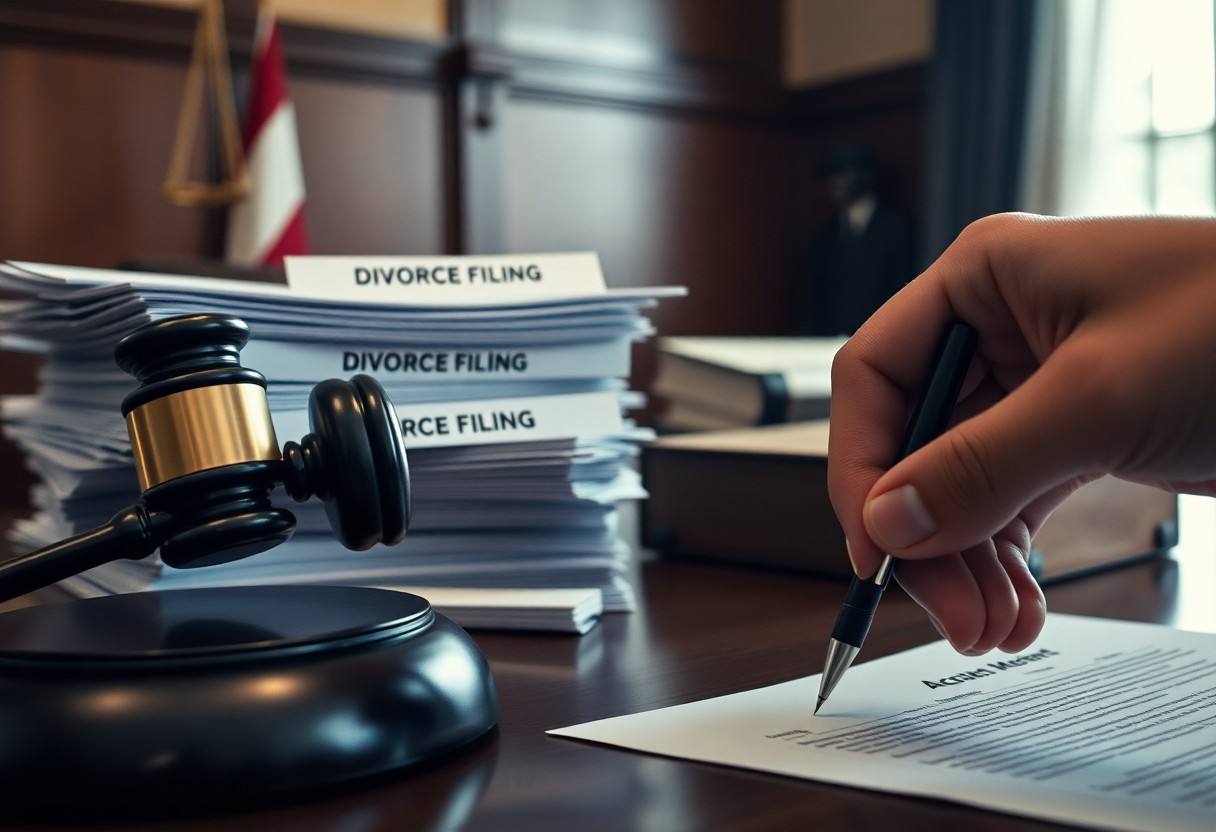In the matter of your divorce, it’s important to consider your mindset, as decisions made during this emotionally charged time can have lasting impacts. If you’ve already filed for divorce but find yourself second-guessing that choice, you may wonder if withdrawal is an option. The good news is that you have the power to change your mind even after filing, but navigating this path requires careful consideration of legal implications, emotional health, and the reactions of your spouse. This post will guide you through what you can do if you wish to reconsider your decision.
Key Takeaways:
- It is possible to change your mind after filing for divorce; doing so requires communication with your spouse and legal representation.
- Withdrawal of the divorce petition can be accomplished, but both parties must agree to move forward together.
- In some jurisdictions, a waiting period may need to be observed before formally withdrawing the filing.
- Filing for divorce does not automatically end a marriage; a divorce necessitates a court decision to finalize the separation.
- Emotional considerations play a significant role in the decision to withdraw from divorce proceedings.
- Legal counsel can provide guidance on the implications of changing your mind regarding divorce and any necessary steps involved.
- Considerations should include the impact on children and shared financial responsibilities when reassessing the decision to divorce.

The Emotional Landscape of Divorce Decisions
Deciding to file for divorce is never straightforward; the emotional landscape is often complex and tumultuous. You may experience a whirlwind of feelings such as sadness, relief, anger, and even confusion. These emotions can cloud your judgment, making it challenging to distinguish between what you truly want and what you feel in the moment. This emotional turmoil often leads to second-guessing your decision, particularly if you’re faced with the prospect of a significant life change.
Navigating Feelings of Regret
Feelings of regret might surface after you file for divorce, especially if you begin to rethink your decision and the life you built together. You may question whether leaving was the right choice and wonder if reconciliation could be a viable option. This inner conflict can be exhausting, creating a cycle of uncertainty and doubt as you grapple with what has been lost versus what could still be salvaged.
The Impact of External Influences
External influences—friends, family, and even social media—play a significant role in shaping your thoughts post-filing. The opinions and reactions of the people in your life can either bolster your resolve or heighten your doubts. Sometimes, those close to you may encourage you to stick with your decision, while others might emphasize the potential for reconciliation, adding to your confusion. Their perspectives can sway your emotional state, making it crucial to navigate these opinions while remaining true to your feelings and values.
For example, if a close friend shares a positive story about their own reconciliation, it might ignite feelings of nostalgia and hope in you. Similarly, family members who have witnessed the negative aspects of your marriage could amplify your doubt, pushing you to second-guess your path. Balancing these external influences while prioritizing your own emotional wellbeing can be incredibly challenging, but it’s vital to take the time you need to reflect on your personal situation before making any irreversible decisions.

Legal Implications: The Fine Print of Withdrawal
Once you file for divorce, it may not be as simple as just deciding to change your mind. Legal statutes and procedures govern this process, and understanding these intricacies is crucial. The timeline for your divorce proceedings may continue as scheduled, unless you take formal steps to withdraw your petition. Without following proper procedures, you risk defaulting on requests or missing out on critical protections, making it crucial to approach this decision thoughtfully.
Understanding the Divorce Timeline
The timeline for a divorce can vary widely based on your jurisdiction and the specific circumstances of your case. After filing, the court often sets deadlines for responses, hearings, and other procedural steps that can lead to a final judgment. Once initiated, the process typically follows a defined legal pathway, which makes changes complicated and potentially lengthy, depending on when your intent to withdraw is communicated.
Procedures for Reversal
To change your mind after filing for divorce, you must formally notify the court. This usually involves submitting a written request to withdraw your divorce petition, which may need to be filed before any responses or hearings take place. Depending on where you live, specific forms may be required, and some jurisdictions could mandate a hearing to finalize the withdrawal. Failing to follow these procedures might not only delay your process but could also create further legal entanglements.
To successfully navigate the reversal process, check your local court’s rules to ensure you don’t miss any necessary filings or deadlines. Often, courts require both parties to consent to the withdrawal, especially if preliminary hearings or proceedings have commenced. Therefore, if you intend to reconcile, communication with your spouse is crucial, as their agreement could significantly simplify the process. Keep in mind that ongoing issues, such as child custody or property disputes, may still require resolution even if the divorce is withdrawn.
Factors to Consider Before Changing Your Path
- Your emotional readiness to address unresolved issues
- The potential impact on your children and family
- Your financial situation and long-term security
- Underlying relationship dynamics that may not have changed
- The potential for reconciliation and growth
This consideration encompasses practical, emotional, and relational aspects that need thoughtful evaluation before any decisions are made.
Assessing Relationship Dynamics
Understanding the current relationship dynamics is vital when contemplating a change in your divorce path. Take time to honestly evaluate whether the problems that led to the divorce filing are genuinely resolved or simply buried under temporary feelings of hope. If communication patterns, trust issues, and emotional attachments remain unresolved, jumping back into a relationship might lead to similar dissatisfaction in the future.
Evaluating Long-Term Solutions
Thinking about both your immediate feelings and long-term implications is imperative in this decision-making process. Is it possible to explore productive solutions, such as couples therapy or open communication about underlying issues? The potential for meaningful change in your relationship dynamics will heavily influence the sustainability of a reconciled partnership. Consider practical strategies that could enhance your relationship, like attending workshops or seeking relationship coaching, to proactively address concerns together. Evaluate if you can commit to these long-term solutions and establish a healthier future.
Exploring these options in detail helps ensure that if you choose not to proceed with the divorce, you’re doing so with a clear understanding of your relationship’s foundation. Sustainable change often requires considerable effort and planning, making it imperative to engage deeply with the issues at hand to avoid repeating previous mistakes.

Strategies for Open Communication
Establishing open communication is vital when considering a change of heart after filing for divorce. This ensures both partners feel heard and understood, paving the way for potential reconciliation. Prioritize honest discussions about feelings, expectations, and fears to facilitate a constructive dialogue. By fostering an environment of trust, you enable deeper connections and the possibility of resolving underlying issues together.
Initiating Difficult Conversations
Starting tough conversations about the future of your relationship can feel daunting. Choose an appropriate setting to engage in discussion, allowing for a calm and uninterrupted exchange. Be clear about your intentions and feelings, and invite your partner to share their perspective too. This collaborative approach can uncover common ground and help in determining whether to proceed with the divorce or explore alternatives.
The Role of Professional Mediation
Involving a professional mediator can transform difficult conversations into productive dialogues. Mediators are trained in helping conflicting parties navigate their issues efficiently, providing a neutral space for discussion. They guide the conversation, ensuring both voices are equally represented, and can help in uncovering solutions that might not have been recognized otherwise. Furthermore, mediators offer tools for effective communication, making it easier to explore your feelings and needs thoughtfully.
Personal Growth Through the Process
Experiencing a divorce often serves as a catalyst for personal growth. While the process may be tumultuous, it can ultimately lead to a deeper understanding of yourself and your life goals. Embracing the challenges can help you develop resilience and a newfound sense of purpose, allowing you to emerge stronger than before.
Reflecting on Personal Needs and Desires
Amid the chaos of divorce, taking time to reflect on your personal needs and desires can lead to meaningful insights. You might find that your aspirations have evolved over the years or that certain aspects of your life were neglected. This reflection is an opportunity to prioritize what truly matters to you, fostering greater self-awareness and clarity.
Redefining Individual Identity Post-Divorce
Redefining your identity after a divorce is an empowering journey. You have the chance to discover your passions, interests, and strengths outside of your marital relationship. This transformation often encourages you to explore new hobbies, pursue career goals, or invest in self-care, shifting your focus toward individual fulfillment and growth.
As you transition from a couple to being single, you may need to let go of the labels that defined you within the marriage. This phase can involve actively engaging in activities that resonate with your authentic self, connecting with supportive communities, or cultivating friendships that celebrate your individuality. Embracing this process allows you to forge a new identity that reflects your evolving values and aspirations, helping you build a future by design rather than by circumstance. Ultimately, the lessons learned during this period can guide you toward a more enriched and fulfilling life.
To wrap up
So, if you’ve filed for divorce but are having second thoughts, it’s important to know that you do have options. You can withdraw your divorce petition or request a pause in the proceedings. However, the process may vary by jurisdiction and specific circumstances surrounding your case. Consulting with a legal professional can help you navigate these complex emotions and decisions, ensuring that your choices align with your personal goals and situation. Taking the time to reflect can lead to a more informed decision about your next steps.
FAQ
Q: Can I change my mind after filing for divorce?
A: Yes, you can change your mind after filing for divorce. Once the paperwork has been submitted, you still have the right to withdraw your divorce petition before it is finalized. It’s important to communicate openly with your spouse about your desire to reconcile, as well as consider counseling or mediation to help resolve underlying issues.
Q: What steps do I need to take to withdraw my divorce filing?
A: To withdraw your divorce filing, you typically need to file a motion with the court where you submitted your divorce petition. This motion should state your intention to dismiss the divorce and may require your spouse’s agreement, depending on local laws. It is advisable to consult with an attorney to ensure proper procedures are followed.
Q: Is there a time limit for changing my mind after filing for divorce?
A: There is generally no strict time limit for withdrawing your divorce petition, but the sooner you act, the better. If your spouse has already responded or if the court has scheduled hearings, it may complicate the process. Each state has specific rules regarding divorce proceedings, so it’s wise to check those conditions in your jurisdiction.
Q: What happens if my spouse does not agree to my decision to withdraw the divorce?
A: If your spouse does not agree with your decision to withdraw the divorce, you may still be able to proceed with the withdrawal as long as the court has not already finalized the divorce. However, if there are disputes, it could lead to complications, and you might still need to appear before the judge. An attorney can help navigate these disagreements.
Q: Can my spouse still file for divorce if I change my mind and withdraw my filing?
A: Yes, your spouse does have the option to file for divorce even if you choose to withdraw your own petition. If they decide to go ahead with the process, the divorce proceedings will then continue independent of your decision to drop your filing.
Q: What are the potential implications of deciding to withdraw my divorce?
A: Withdrawing your divorce can have emotional implications, especially if your spouse is not on the same page. It may also impact any legal agreements or arrangements that were being discussed, such as custody or asset division. Consulting a professional can help understand the full scope of your decision.
Q: Should I consider legal advice before deciding to withdraw my divorce?
A: Yes, seeking legal advice before making a decision to withdraw your divorce is advisable. An attorney can help you understand the legal ramifications, discuss your options, and assist in navigating communication with your spouse to address any remaining issues that led to the filing in the first place.
